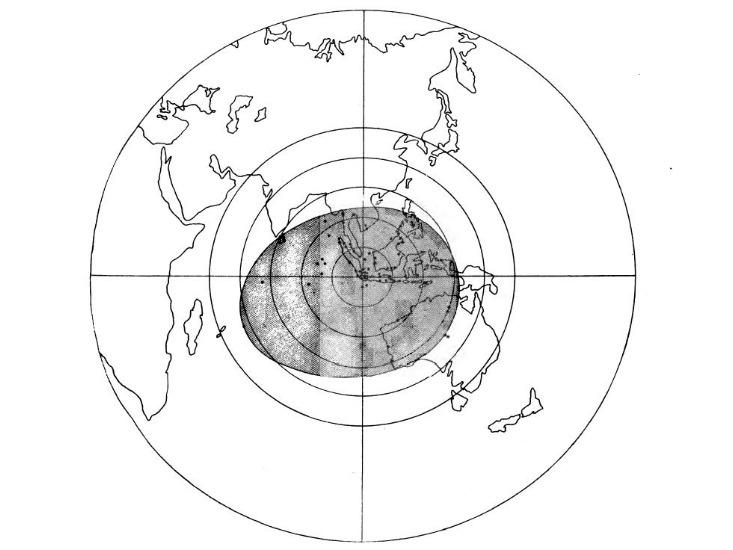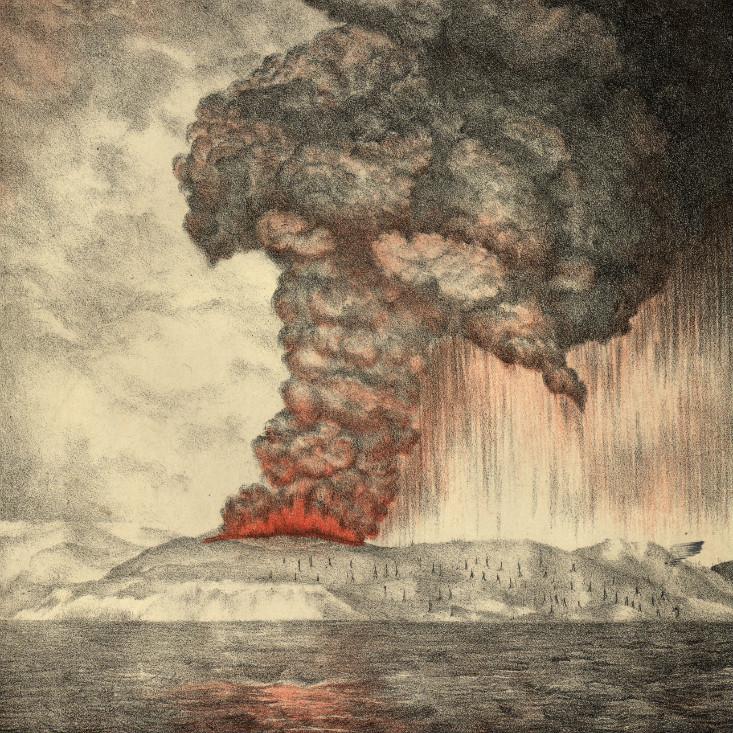Incredibly loud sound that circled the earth four times

On August 27, 1883, the Earth produced a sound whose volume has not been surpassed since.
Sound was born on the island of Krakatau, located between Java and Sumatra in Indonesia, at 10:02 am local time. He was heard in 2080 km on the Andaman and Nicobar Islands (“amazing sounds were heard, like a cannon firing”); 3200 km in New Guinea and Western Australia ("a series of loud sounds resembling artillery in the direction of the north-west"); and even 4800 km in the Indian Ocean on the island of Rodrigues near Mauritius (“a sound coming from the east, as if a distant roar of heavy cannons”) [1]. In total, it was heard by people in 50 different geographical locations covering 1/13 of the globe.
')
Think about how amazing it is. If in Nizhny Novgorod someone tells you that you heard a sound from Moscow, you look at it with suspicion. But Nizhny Novgorod is located 400 km from Moscow. And in the case described, it was as if a person who was in Chita heard a sound coming from Moscow. With a speed of movement of 1233 km / h, the sound takes about 4 hours to overcome this path. It was the most distant sound in the story we know.

From where it was possible to hear the eruption
So what could create such a loud explosion? At Krakatau, a volcanic eruption occurred, so powerful that it tore up the island , and released a column of smoke that rose 27 kilometers into the atmosphere, according to a geologist observing it. From this we can calculate that the smoke exploded from the volcano at a speed of 2500 km / h - that is, about 800 m / s. This is twice the speed of sound.
The explosion created a deadly tsunami with waves 30 meters high. 165 coastal villages and settlements were washed away and completely destroyed. Colonists from the Netherlands, who ran at the time in Indonesia, estimated the number of victims at 36,417, but according to some estimates, there could be about 120,000. [2, 3]
The British ship "Castle Norem" during the eruption was 40 miles from Krakatau. The captain wrote in a magazine, “The explosions were so loud that half of my team had damaged eardrums. My last thoughts were about my dear spouse. I am convinced that the Day of Judgment has arrived. ”

Lithograph of the eruption, 1888
But the sounds did not arise because of the end of the world, but because of the fluctuations in air pressure. The barometer at the gas plant in Batavia (now Jakarta), 160 km from the site of the explosion, recorded an increase in pressure of 6 mm Hg. This is about 172 dB of sound pressure, very loud noise. When working with a jackhammer, you are subjected to a pressure of 100 dB. The pain threshold of a person is about 130 dB, and if you had unsuccessfully stood next to a jet engine, you would be subjected to a pressure of 150 dB. (An increase of 10 dB is roughly estimated by a person as a twofold increase in volume). During the Krakatau eruption, 172 dB were recorded at a distance of 160 km. It is so amazingly loud that it is practically on the edge of the concept of "sound."
When you hum a song or say the words, you force the air molecules to oscillate forward and backward tens or hundreds of times a second, causing air pressure to increase in some places and decrease in others. The louder the sound, the more intense the fluctuations and the greater the fluctuations in pressure. But there are restrictions on the volume of the sound. At some point, the oscillations become too large, and the lower pressure bar drops to zero — to a vacuum — and will not lower below. This limitation in the Earth’s atmosphere is reached at about 194 dB. Even louder, and the sound will no longer spread through the air, it will carry air with it, creating a moving high-pressure area, a shock wave.
Closer to Krakatau, the sound exceeded all limitations, and created such a powerful rush of high pressure air that it tore the eardrums of the sailors 40 miles away. Having traveled thousands of kilometers, having reached Australia and the Indian Ocean, the vibrations of sound diminished, and began to resemble a distant shot. After 4800 km of travel, the pressure wave became too quiet for the human ear, but continued to spread further, reflecting for several days around the globe. The atmosphere rang like a bell, imperceptibly for us, but noticeable for our instruments.
In 1883, weather stations in cities around the world used barometers to track changes in atmospheric pressure. 6 hours 47 minutes after the Krakatau eruption, a surge of pressure was recorded in Calcutta. After 8 hours, the momentum reached Mauritius in the west and Melbourne with Sydney in the east. After 12 hours, the impulse was noticed in St. Petersburg, and then in Vienna, Rome, Paris, Berlin and Munich. After 18 hours, the impulse reached New York, Washington and Toronto. Incredibly, for as long as five days after the explosion, weather stations in 50 cities around the world recorded this unprecedented surge in pressure, repeating approximately every 34 hours. It takes about as much time for the sound to travel around the entire planet.
In general, the pressure wave from Krakatau bypassed the globe 3-4 times in each direction. Up to seven spikes of pressure were recorded in the cities, as they sensed the shock waves that came to them from both sides. Tidal stations in India, England and San Francisco have noted an increase in ocean waves simultaneously with an air pulse, and this effect was noted for the first time. It was a sound that could no longer be heard, but he continued to travel around the world — this phenomenon was called the “great air wave.”
Recently, tourists shot an incredible video of a volcanic eruption in Papua New Guinea. If you look closely, you can get an idea of the pressure wave created by a volcano from it.
A volcanic eruption causes a sudden surge in atmospheric pressure. It can be seen as it moves through the air and condenses water vapor into the clouds along the way. The videos that were shot were, fortunately, far enough away from the eruption, and it took some time for the pressure wave to reach them. When a wave hits a boat, about 13 seconds after the explosion, a loud sound like a shot is heard along with a gust of air. This means that the boat was about 4.4 km from the volcano. Something similar happened with Krakatau, only then the “shot” was heard not at 4 km, but 4800 km from the volcano, which demonstrates the incomprehensible and tremendous destructive force of nature.
Links
1. Judd, JW, et al. The Eruption of Krakatoa, and Further Phenomena Trübner & Company, (1888).
2. Winchester, S. Krakatoa: The Day of the World Exploded Penguin, London, United Kingdom (2004).
3. Simkin, T. & Fiske, RS Krakatau, 1883, the Volcanic Eruption and the Smithsonian Institution Scholarly Press, Washington, DC (1983).
Source: https://habr.com/ru/post/399313/
All Articles